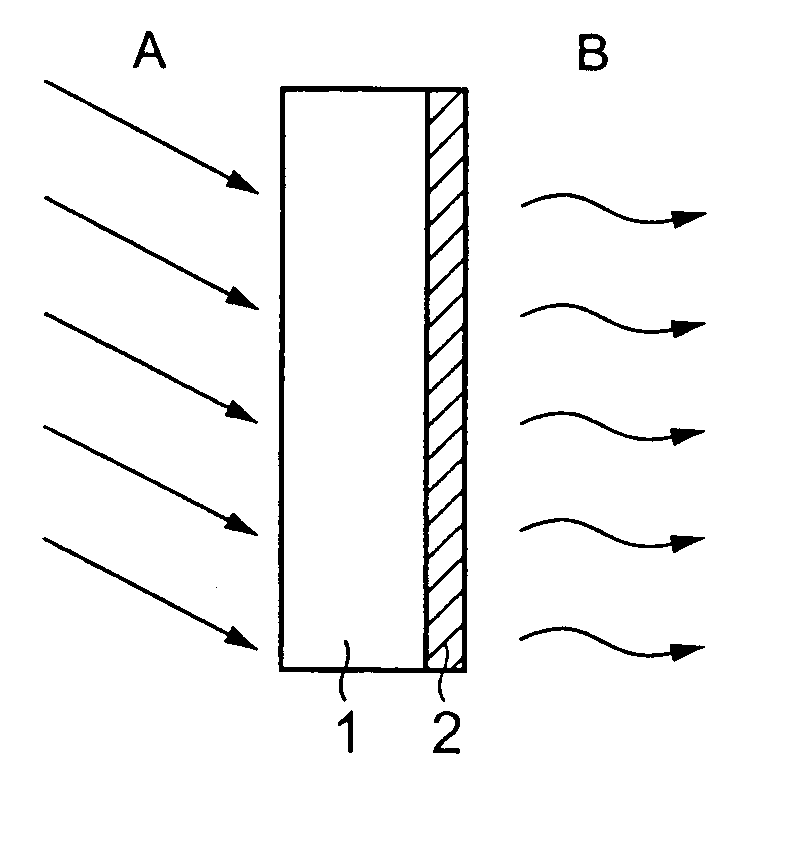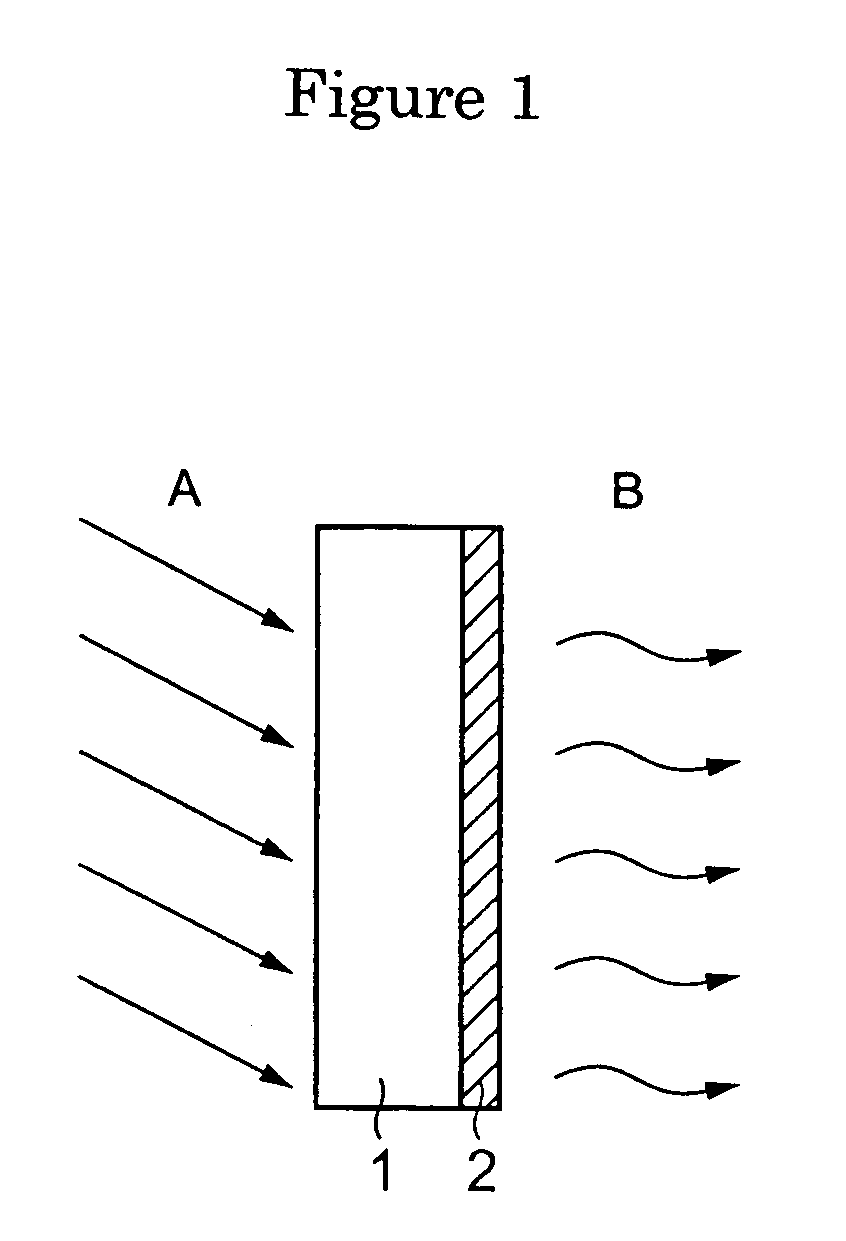Water-based heat-radiation-preventive coating matrial for glass, heat-radiation-preventive glass,and method of preventing heat radiation
a technology of heat radiation prevention and coating matrial, applied in the direction of radiation-absorbing paints, other domestic articles, transportation and packaging, etc., can solve the problems of reducing the effectiveness of air conditioners, reducing the transparency of glasses in visible light zones, and increasing the cost of glasses, so as to achieve easy and inexpensive, excellent adhesion to glasses, and uniform durability
- Summary
- Abstract
- Description
- Claims
- Application Information
AI Technical Summary
Benefits of technology
Problems solved by technology
Method used
Image
Examples
example 1
[0114] Deionized waters having the total anion content of 51.3, 102.7, 302.5, 558.9 and 750 respectively (each unit was “mgCaCO3 / L”) were prepared by adding salt-consisting materials of CaCO3, NaCl, KCl, MgSO4 and FeSO4, and SiO2 as a free acid in water purified by using a cation-exchange resin and an anion-exchange resin.
[0115] N-β (amino ethyl) γ-amino propyl triethoxy-silane (bland name “KBM603”: manufactured by Shin-Etsu Chemical Co., Ltd.) was dissolved in the above water, to prepare solutions of 0.001%, 0.005%, 0.01%, 0.1%, 1.0%, 3.0%, 5.0% and 6.0% (each was “% by weight”; it is the same as that of the following) . Then, these solutions were put in the constant temperature bath kept at 60° C., and the state of gelation of the solutions after 24-hour progress was checked by visual observation. The result was shown in Table 1.
TABLE 1Silane couplingTotal anion contentTotal anion contentTotal anion contentTotal anion contentTotal anion contentagent51.3 mgCaCO3 / L102.7 mgCaCO3 / L...
example 2
[0117] In the solution wherein 1.2% by weight of acetic acid was mixed with the deionized water prepared in Example 1, γ-glycidoxy propyl trimethoxy silane (“KBM403”: manufactured by Shin-Etsu Chemical Co., LTD.) was dissolved to prepare solutions of 0.001%, 0.005%, 0.01%, 0.1%, 1.0%, 3.0%, 5.0% and 6.0%. Then, these solutions were put in the constant temperature bath kept at 60° C., and the state of gelation of the solutions after 24-hour progress was checked by visual observation. The result was shown in Table 2.
TABLE 2Silane couplingTotal anion contentTotal anion contentTotal anion contentTotal anion contentTotal anion contentagent51.3 mgCaCO3 / L102.7 mgCaCO3 / L302.5 mgCaCO3 / L558.9 mgCaCO3 / L750 mgCaCO3 / L0.001%⊚⊚⊚⊚⊚0.005%⊚⊚⊚⊚⊚ 0.01%⊚⊚⊚⊚⊚ 0.1%⊚⊚⊚⊚⊚ 1.0%⊚⊚⊚⊚⊚ 3.0%⊚⊚⊚⊚Δ 5.0%⊚⊚⊚⊚Δ 6.0%⊚⊚⊚⊚Δ
⊚: Not gelated
Δ: A little gelated
X: Much gelated
[0118] It turns out that the gelation occurs when γ-glycidoxy propyl trimethoxy silane (“KBM403”: manufactured by Shin-Etsu Chemical Co., LTD.) is ...
example 3
[0119] In the deionized water prepared in Example 1, a silane coupling agent (“KBM6123”: manufactured by Shin-Etsu Chemical Co., LTD.) was dissolved to prepare solutions of 0.001%, 0.005%, 0.01%, 0.1%, 1.0%, 3.0%, 5.0% and 6.0%. Then, these solutions were put in the constant temperature bath kept at 60° C., and the state of gelation of the solutions after 24-hour progress was checked by visual observation. The result was shown in Table 3.
TABLE 3Silane couplingTotal anion contentTotal anion contentTotal anion contentTotal anion contentTotal anion contentagent51.3 mgCaCO3 / L102.7 mgCaCO3 / L302.5 mgCaCO3 / L558.9 mgCaCO3 / L750 mgCaCO3 / L0.001%⊚⊚⊚⊚Δ0.005%⊚⊚⊚⊚Δ 0.01%⊚⊚⊚⊚Δ 0.1%⊚⊚⊚⊚Δ 1.0%⊚⊚⊚⊚Δ 3.0%⊚⊚⊚⊚Δ 5.0%⊚⊚⊚⊚X 6.0%⊚⊚⊚⊚X
⊚: Not gelated
Δ: A little gelated
X: Much gelated
[0120] It turns out that the gelation occurs when a silane coupling agent (“KBM6123”: manufactured by Shin-Etsu Chemical Co., Ltd.) is mixed with deionized water having the total anion content of more than 700 mgCaCO3 / L.
PUM
| Property | Measurement | Unit |
|---|---|---|
| visible light transparency | aaaaa | aaaaa |
| visible light transparency | aaaaa | aaaaa |
| visible light transparency | aaaaa | aaaaa |
Abstract
Description
Claims
Application Information
 Login to View More
Login to View More - R&D
- Intellectual Property
- Life Sciences
- Materials
- Tech Scout
- Unparalleled Data Quality
- Higher Quality Content
- 60% Fewer Hallucinations
Browse by: Latest US Patents, China's latest patents, Technical Efficacy Thesaurus, Application Domain, Technology Topic, Popular Technical Reports.
© 2025 PatSnap. All rights reserved.Legal|Privacy policy|Modern Slavery Act Transparency Statement|Sitemap|About US| Contact US: help@patsnap.com



